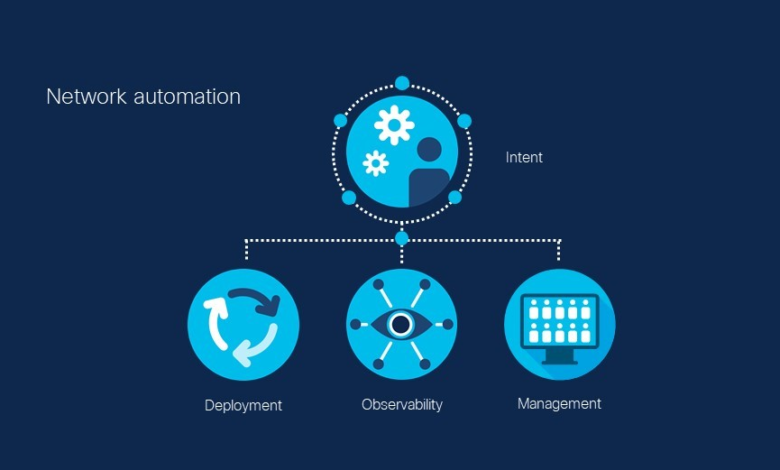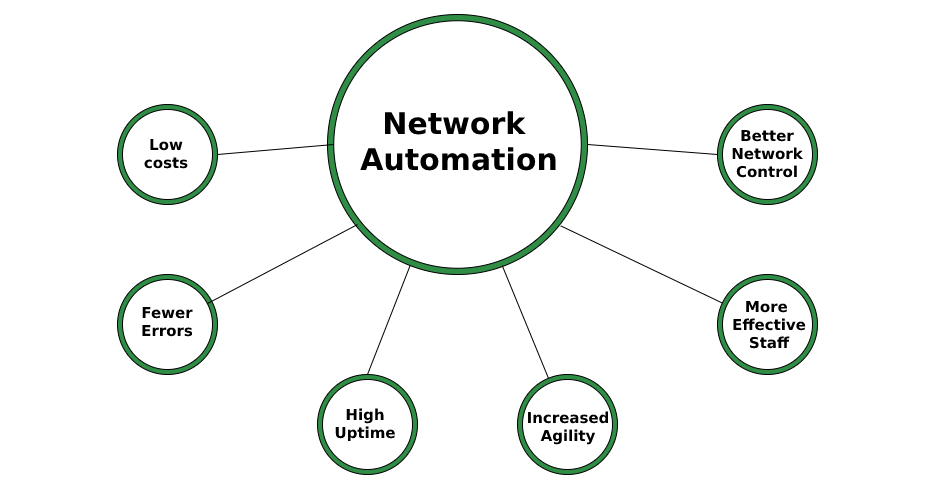What is Network Automation? Full Description

What if your network could configure, troubleshoot, and secure itself all without constant manual oversight? Network Automation is transforming that possibility into reality, turning once time-consuming, error-prone tasks into seamless, automated processes. In today’s fast-paced digital landscape, managing complex networks by hand is no longer feasible. Automation empowers IT teams to handle vast, intricate systems effortlessly, boosting efficiency, scalability, and security. With Network Automation, organizations can now focus on innovation rather than routine maintenance. Explore how automated networks are revolutionizing infrastructure management, building a future where networks operate at the speed of business.
Table of Contents
What is Network Automation?

Network automation is the process of using software to automate network tasks traditionally performed by network engineers and administrators. It encompasses everything from basic tasks, like configuration adjustments, to complex processes, such as troubleshooting and optimization. Essentially, it allows networks to adapt, expand, and react to various conditions without human involvement, delivering a faster, more consistent, and more reliable network performance.
By leveraging tools, scripts, and platforms, network automation minimizes the need for repetitive, manual tasks. This not only reduces the workload on IT teams but also enhances efficiency, making network management more scalable and resilient. In a world where downtime can lead to significant losses, automated networks provide a shield against vulnerabilities and inefficiencies.
In the era of digital transformation, Network Automation is not just a luxury—it’s a necessity for businesses striving for efficiency and agility.
Types of Network Automation
1- Device-Level Automation
Device-Level Automation is a foundational aspect of Network Automation, focusing on the individual management and configuration of network devices like routers, switches, and firewalls. Through predefined scripts and automated protocols, device-level automation streamlines essential tasks—such as firmware updates, configuration adjustments, and security patches—across each device in the network. This granular approach ensures that each device operates in harmony with the broader network, enhancing both reliability and security. By removing the need for manual updates, Network Automation at the device level not only reduces errors but also saves time, empowering IT teams to scale network operations with greater ease and precision.
2- Network-Level Automation
Network-Level Automation is an advanced layer of Network Automation that orchestrates and manages the entire network as a cohesive system rather than handling individual devices. By automating network-wide tasks—such as routing adjustments, load balancing, and traffic prioritization—this approach optimizes overall network performance and resilience. Network-level automation enables rapid scaling, as configurations can be deployed across multiple devices simultaneously, ensuring consistent connectivity and seamless communication. This holistic automation not only simplifies complex architectures but also minimizes potential disruptions, empowering networks to respond dynamically to changing demands and workloads. Ultimately, Network Automation at the network level creates a flexible and adaptive infrastructure capable of supporting business growth and innovation.
3- End-to-End Automation
End-to-End Automation is the pinnacle of Network Automation, covering the entire lifecycle of network management—from provisioning and configuration to monitoring and optimization. This comprehensive approach ensures that every facet of the network operates in harmony, seamlessly automating complex processes across multiple layers and devices. End-to-end automation empowers networks to self-adjust and self-optimize in real-time, responding intelligently to changing demands without manual intervention. By integrating all network components under a unified automation strategy, organizations achieve unparalleled consistency, security, and operational efficiency. This holistic application of Network Automation enables resilient, scalable networks that are agile enough to evolve alongside business needs.
4- Service-Level Automation
Service-Level Automation is a specialized form of Network Automation that focuses on maintaining the performance and availability of network-based services. It automates critical tasks like load balancing, failover management, and resource allocation to ensure that service levels meet or exceed defined standards. By intelligently monitoring traffic patterns and adapting in real time, service-level automation helps prevent bottlenecks and service disruptions. This approach ensures a consistent user experience, even during peak demands, and reduces the need for manual interventions. In essence, Network Automation at the service level enhances network reliability, fortifies security, and supports seamless, uninterrupted service delivery across all layers.
With Network Automation, the future of network management is not only faster but smarter, driving innovation and ensuring reliability at every step.
Purpose of Network Automation
- Increased Efficiency : Network automation minimizes the time spent on repetitive tasks, allowing IT teams to focus on strategic projects. Automated workflows reduce operational delays, leading to faster deployments and updates across network devices.
- Enhanced Scalability : In rapidly growing environments, scaling network infrastructure manually is labor-intensive and time-consuming. Network Automation enables networks to adapt quickly to increased demands, adding or configuring devices without the need for extensive human oversight.
- Improved Reliability : Manual configurations can lead to inconsistencies and errors, especially in complex networks. Automation ensures consistency across the board, reducing human errors and enabling high availability, even during peak demands.
- Optimized Security : Automated security protocols help organizations respond more quickly to threats. By automating tasks such as access controls, patching, and vulnerability scanning, network automation fortifies the network’s defense, enhancing resilience against cyberattacks.
- Cost Savings : Reducing manual tasks lowers labor costs and minimizes the risks associated with human error. With Network Automation, businesses save both time and money while benefiting from a more efficient network.
Tools and Languages Used in Network Automation
1- Python
Python has become an indispensable tool in Network Automation, thanks to its simplicity and versatility. Widely recognized for its readability, Python allows network engineers to script complex automation tasks with ease. With powerful libraries like Netmiko, NAPALM, and Paramiko, Python facilitates seamless communication between devices, configuration management, and real-time troubleshooting. Its ability to integrate with diverse networking platforms makes it the go-to language for automating repetitive tasks, enhancing efficiency, and reducing human error. As networks become increasingly complex, Python’s role in Network Automation continues to grow, empowering organizations to streamline operations and scale dynamically.
2- Go
Go, also known as Golang, is rapidly gaining traction in the realm of Network Automation for its speed and efficiency. Designed for scalability, Go excels in managing concurrent tasks, making it ideal for automating complex, distributed networks. Its ability to handle multiple processes simultaneously allows network engineers to streamline operations and improve performance across large-scale environments. With a robust set of libraries and strong support for API interactions, Network Automation through Go enables seamless integration and real-time updates. Its lightweight nature and simplicity make it a powerful choice for building fast, reliable tools that optimize network infrastructure.
3- YAML
YAML (YAML Ain’t Markup Language) is a powerful, human-readable data serialization format widely used in Network Automation. Its simple structure allows engineers to define configurations and automation tasks with minimal complexity. As a cornerstone of tools like Ansible and Puppet, YAML enables the efficient orchestration of network devices, simplifying the process of managing large, dynamic infrastructures. With its intuitive syntax, tasks, from device configurations to service management, can be described clearly and concisely. YAML’s ability to express complex data in a clean, readable format makes it an essential tool for streamlining network operations and ensuring consistency across configurations.
4- JSON
JSON (JavaScript Object Notation) plays a crucial role in Network Automation by providing a lightweight, easy-to-parse format for transmitting data between devices and applications. Its simplicity and flexibility make it an ideal choice for configuring network systems and managing automation tasks. relies on JSON to define and share structured data, whether it’s for API integrations, device configurations, or real-time network updates. The format’s hierarchical structure allows for efficient data exchange, ensuring consistency and scalability across diverse environments. With its widespread use in cloud services and modern network management tools, JSON remains a key element in automating and optimizing network infrastructures.
5- Shell Scripting (Bash)
Shell Scripting (Bash) is a fundamental tool , is offering a powerful yet flexible way to automate repetitive tasks directly within the network’s command line interface. With its concise syntax and ability to invoke system utilities, Bash scripts can manage configurations, execute network diagnostics, and automate device provisioning. Network Automation through shell scripting allows engineers to efficiently execute batch operations across multiple devices, reducing manual effort and minimizing errors. By combining simplicity with the full power of the underlying operating system, Bash remains an indispensable tool for automating complex network workflows and enhancing operational efficiency.
Future of Network Automation
- Integration of AI and Machine Learning : The next generation will incorporate AI and machine learning to enable predictive analytics, self-healing networks, and adaptive traffic management.
- Seamless Support for Emerging Technologies : With the growth of 5G, IoT, and edge computing, automation will evolve to handle the complexity of these new technologies, optimizing network performance in real time.
- Self-Optimizing Networks : Automated systems will proactively adjust configurations, ensuring optimal network performance without manual intervention, reducing downtime and errors.
- Intent-Based Networking : Network Automation will empower IT teams to define high-level business objectives, while automation systems autonomously execute the required tasks, further simplifying network management.
- Strategic Business Enabler : As automation matures, it will become a key driver for business agility, security, and scalability, transforming network management from a tactical task to a strategic advantage.
Advantages of Network Automation
| Advantage | Description |
| Increased Efficiency | Network Automation eliminates repetitive manual tasks, enabling faster execution of network configurations and changes. This leads to improved operational efficiency and a more streamlined workflow for network management. |
| Reduced Human Error | Automating network processes minimizes the risk of human error during configurations and troubleshooting, leading to more reliable and consistent network performance. |
| Scalability | Automation enables networks to scale seamlessly as business demands grow. Configurations and updates can be deployed quickly and consistently across large, distributed environments, making it easier to manage network expansion. |
| Cost Savings | By reducing the need for manual intervention, Network Automation lowers operational costs. Automation also allows organizations to optimize resource usage, further enhancing cost efficiency. |
| Enhanced Security | Automated processes ensure that security protocols, patches, and updates are applied consistently and promptly, reducing vulnerabilities and increasing overall network security. |
| Faster Troubleshooting | Network Automation allows for quicker detection and resolution of network issues through automated monitoring and diagnostics. This results in reduced downtime and better network reliability. |
| Consistency and Standardization | Automation ensures uniformity in network configurations, preventing discrepancies and misconfigurations that could lead to inefficiencies or outages. This consistency is crucial for maintaining reliable network operations. |
| Better Compliance | Automated systems can enforce regulatory and compliance requirements by ensuring that configurations adhere to industry standards, reducing the risk of non-compliance. |
Disadvantages of Network Automation
| Disadvantage | Description |
| Initial Setup Complexity | Implementing Network Automation can be complex, requiring time, resources, and expertise to set up automated processes and integrate them into existing network infrastructures. The initial configuration phase may require significant effort. |
| Dependency on Automation Tools | Relying heavily on automated systems can lead to a dependence on specific tools or platforms. If these tools encounter failures or limitations, network management may become problematic, potentially creating vulnerabilities. |
| Lack of Flexibility | Automated processes can sometimes lack the flexibility to adapt to unique or unforeseen situations, requiring manual intervention when network conditions change unexpectedly or when custom configurations are needed. |
| Security Risks | While automation improves security in many cases, misconfigured automation scripts or processes could create security vulnerabilities. Automated systems may also be targeted by malicious actors who exploit weaknesses in the automation setup. |
| Potential Job Displacement | The widespread use of Network Automation could reduce the need for some manual roles in network management, potentially leading to job displacement for network engineers who rely on traditional methods. |
| High Initial Costs | While Network Automation can lead to long-term savings, the upfront costs—such as purchasing tools, training staff, and reconfiguring infrastructure—can be high, especially for small businesses. |
| Over-Automation | Over-reliance on automation might lead to situations where human oversight is necessary but not provided. This could result in poor decision-making or the inability to react to sudden network crises effectively. |
| Maintenance Overhead | Automated systems require ongoing maintenance, updates, and monitoring to ensure they continue functioning properly. This maintenance can become cumbersome over time, particularly in large-scale networks. |
Network Configurations
Network Configurations are the foundational elements that define how devices within a network communicate with each other. They encompass settings like IP addressing, routing protocols, access control lists (ACLs), and security parameters. Network Automation has revolutionized the way these configurations are applied and managed. Instead of manual entry, automation tools can push configurations across multiple devices at once, ensuring consistency and reducing the chance for errors.
Through Network Automation, the configuration process becomes streamlined, allowing for quicker updates, more efficient resource allocation, and a more robust network infrastructure. Automation not only ensures uniformity but also enables faster scaling of networks. The ability to automatically adapt configurations in response to traffic loads, security concerns, or performance metrics further enhances the network’s flexibility. As networks grow increasingly complex,it will continue to be essential in maintaining their integrity and performance.
Conclusion
In conclusion, is transforming the way networks are managed, bringing efficiency, scalability, and precision to organizations. As networks grow in complexity, the need for automation becomes undeniable. By automating routine tasks and configurations, reduces human error, enhances security, and accelerates performance. It offers businesses the agility to respond swiftly to evolving demands while ensuring consistent and reliable network operations. As the future unfolds, embracing will be crucial for organizations striving to stay competitive and future-proof their infrastructure. The shift towards automation is not just a technical evolution, but a strategic necessity.
Embracing Network Automation allows organizations to scale effortlessly, minimize errors, and stay ahead in an increasingly complex digital landscape.
(FAQ) on the topic of Network Automation:
- What is Network Automation?
- refers to the use of software tools and technologies to automate the management, configuration, and monitoring of network devices and services.
- How does Network Automation improve network management?
- By automating routine tasks, enhances efficiency, reduces human error, and speeds up network provisioning and troubleshooting.
- What are the benefits of implementing Network Automation?
- offers numerous benefits, including improved scalability, enhanced security, reduced operational costs, and faster response times to network changes.
- What tools are used in Network Automation?
- Common tools used in Network Automation include Ansible, Puppet, Chef, and Cisco DNA Center, which help automate network configurations, monitoring, and updates.
- Is Network Automation secure?
- Yes, can improve network security by consistently applying updates, security patches, and configurations, reducing vulnerabilities and manual errors.
- How does Network Automation impact network scalability?
- Network Automation allows businesses to scale their networks quickly and efficiently, as it automates configuration tasks across a large number of devices without manual intervention.
- What is the future of Network Automation?
- The future of Network Automation involves integrating advanced technologies like AI, machine learning, and 5G to create smarter, more adaptive networks with minimal human intervention.
- Can Network Automation reduce network downtime?
- Yes, can significantly reduce downtime by enabling rapid identification and resolution of issues, ensuring continuous network performance.
- How do I get started with Network Automation?
- To get started, begin by evaluating your network’s needs, selecting the right tools, and training your team to implement automated processes.




Can you be more specific about the content of your article? After reading it, I still have some doubts. Hope you can help me.